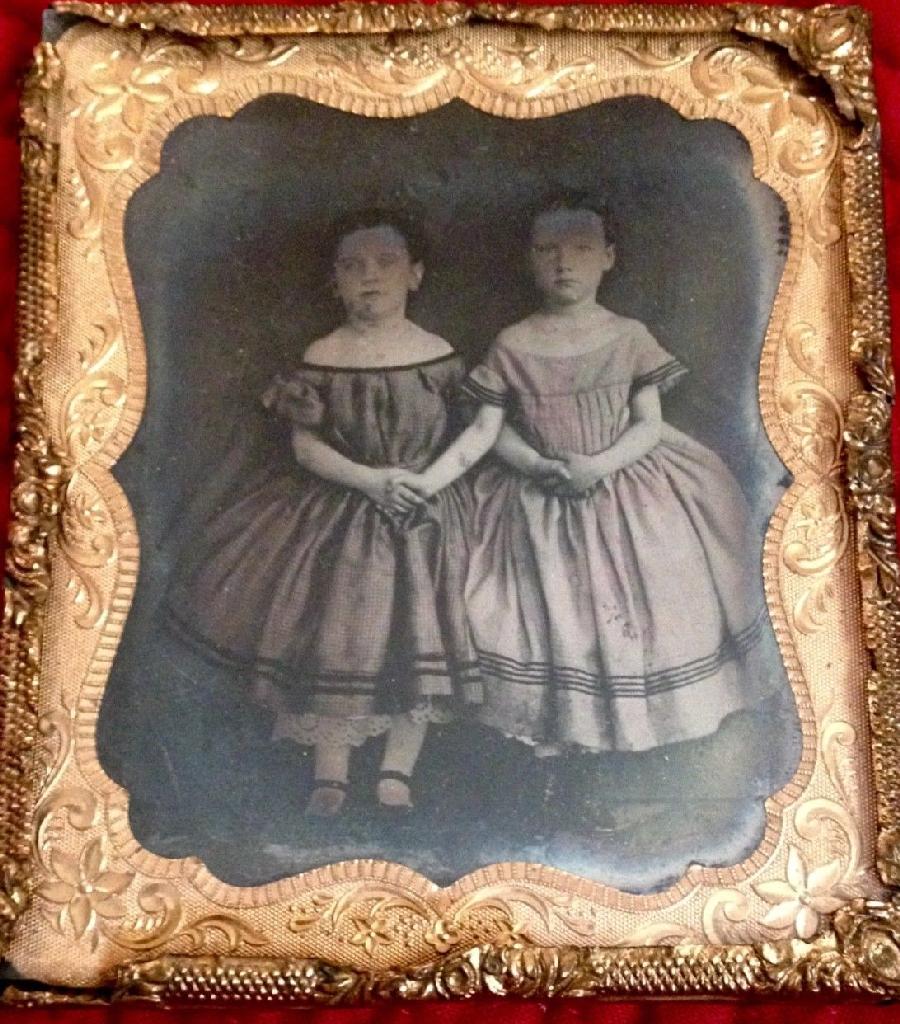

American Girls' Clothing: Skirted Garments--Chronology

Figure 1.--Here we see two unidentified girls wear dresses with low necklines and very full skirts. Notice the panhtalettes.We at first thought it was taken in the 1840s, but as it is an Ambro it would have been taken in the mid- or late-50s, possibly the early-60s. | |
The primary garments worn by girls has been skirted garments. This has been the case for centuries. The primary garment has been the dress, a garment combining the bodice and skirt. I has over time been done in endless variety of styles, decoration, fabric, color and patterns. The dress has been worn in most countries. The dress appears to have evolved from the Western dress appears to have evolved from the robes worn in ancient Greece and Rome. Of course European fashions only reached what is now the United States (17th century). Interestingly, a garment which might be called a dress was worn by women and girls in many North American tribes. The only other skirted garment of comparable importance is the skirt, usually worn with a blouse. The skirt was generally seen as a more informal alternative to the dress. We are not entirely sure about the chronology of skirt. There are other skirted garments, two of them (the kilt and tunic) are mostly seen as a male garment. Other skirted garments have developed over time. We note pinafores appearing (we think in the 18th century). And we note smocks appearing (19th century). We only note women and girls wearing dresses until fairly recently. Emilia Bloomer invented bloomers a form of baggy pants seen as less restrictive than dresses for outdoor activity (1840s). We note a few American girls wearing pants, mostly overalls (early-20th century). This was almost entirely limited to rural areas. After World War I we begin to see girls wearing rompers, shorts and long pants, motley for casual; recreational activities (1920s). Dresses and skirts continued to be the primary garments worn by girls. This did not change until the 1970s. Girls still wore dresses and skirts, but shorts and long pants became widely worn even at school. Dresses remained, however, not only common, but the standard garment when dressing up.
Earlier Centuries
The primary garments worn by girls has been skirted garments. This has been the case for centuries. Of course, unlike Europe, American history does not go back centuries. The primary garment has been the dress, a garment combining the bodice and skirt. It has over time been done in endless variety of styles, decoration, fabric, color and patterns. The dress has been worn in most countries. The dress appears to have evolved from the Western dress appears to have evolved from the robes worn in ancient Greece and Rome. Of course European fashions only reached what is now the United States (17th century). and that settlements was limited to relatively small numbers along a narrow Atlantic seabord area (18th century). Interestingly, a garment which might be called a dress was worn by women and girls in many North American tribes. The only other skirted garment of comparable importance is the skirt, usually worn with a blouse. The skirt was generally seen as a more informal alternative to the dress.
The 18th Century
We are not entirely sure about the chronology of the skirt. There are other skirted garments, two of them (the kilt and tunic) are mostly seen as a male garment. Other skirted garments have developed over time. We note pinafores appearing (we think in the 18th century). We are limited to paintings and drawing for image of 18th century dress. And here we almost entirely notice dresses. Of course reliance on art means we mostly see what the affluent city women were wearing--mimicking European fashion. Most Americans in the 18th century lived on small family farms in rural, area--something like 95 percent. Many of these people had very limited connection with the world of fashion. And we are not sure how many were wearing dresses as opposed to blouses and skirts.
The 19th Century
We know much more about the 19th century, but not until the invention of photography in France (1839). Photography quickly spread to America, in fact photography quickly became more prevalent in America than Europe. Even so, we have the same social-class bias as with art, we mostly see the more affluent segment of the population. That said, photographs were much less expensive than paintings so we see a wide view of the social spectrum than ever before. And this expanded as photographs fell in price and the American people became increasingly prosperous and urbanized as the century progressed, meaning more and more people could indulge in fashion. Here we see the dresses girls were wearing when photography appeared at mid-century (figure 1). And in the final decades of the century, mail order catalogs brought the latest fashions to even the most remote corners of the country. The photographic record clearly show women and girls mainly wearing dresses. Of course, women and girls mostly wore their best clothes when having portraits taken. At the end of the decade we have an important new source appear--school photography. There is also information on individual schools. Again we mostly see girls coming to school in dresses, rather than blouses and skirts. We note smocks appearing (19th century), but they were not as important as in Europe. We only note women and girls wearing dresses until fairly recently. Pinafores were an important garment. Emilia Bloomer invented bloomers a form of baggy pants seen as less restrictive than dresses for outdoor activity (1840s),but very few women or girls actually wore them.
With the 20th century we finally have an ginormous photographic record giving us a very detailed view of how women and girls dressed. Finally the studio portraits which dominated 19th century photography was supplemented with the snapshot. Kodak introduced the Brownie (1900) which put simple low cost photography into most interested Americans. Over night this revolutionized the photographic record. There were snapshots in the late-19th century, but not very many. Kodak and the companies that followed them generated a tidal wave of photographs showing people in every aspect of their daily lives. This meant we see images from all over America and we see girls involved in much more than formal activities. In fact all of the activities girls engaged in, both at home and away from home. We still see women and girls still mostly wearing dresses, but blouses and skirts are now a very important part of the photographic record. Interestingly, girls continued to mostly wear dresses to school until well after World War II. This can easily be seen in school photography. There is also information on individual schools. We note a few American girls beginning to wear pants, mostly overalls (early-20th century). This was almost entirely limited to rural areas. Pinafores were still important at the turn-of-the 20th century, but rapidly went out of fashion, especially after the 1900s decade. After World War I we begin to see girls wearing rompers, shorts and long pants, mostly for casual/recreational activities (1920s). Short pants gradually increased in popularity for casual/play wear. Dresses and skirts continued to be the primary garments worn by girls. This did not change until the 1970s. Girls still wore dresses and skirts, but shorts and pants (especially jeans) became widely worn. Even at school. There was first resistance from school authorities who eventually had to conced to the inevitable. Of course with their focus on fashion, turned jeans into fashionable wear. Dresses remained, however, not only common, but the standard girl's garment when dressing up.
HGC

Navigate the Boys' Historical Clothing Web Site:
[Return to the Main American girls skirted garment page]
[Return to the Main American tunic gender page]
[Return to the Main American girls garment page]
[Return to the Main American girls page]
[Return to the Main girls country page]
[Return to the Main girls page]
[Introduction][Activities] [Biographies][Chronologies][Clothing styles] [Countries][Chronology][Theatricals]
[Bibliographies][Contributions][FAQs][Glossaries][Images][Links][Registration][Tools]
[Boys' Clothing Home]
Created: 9:05 AM 11/30/2012
Last updated: 5:05 AM 8/7/2017




